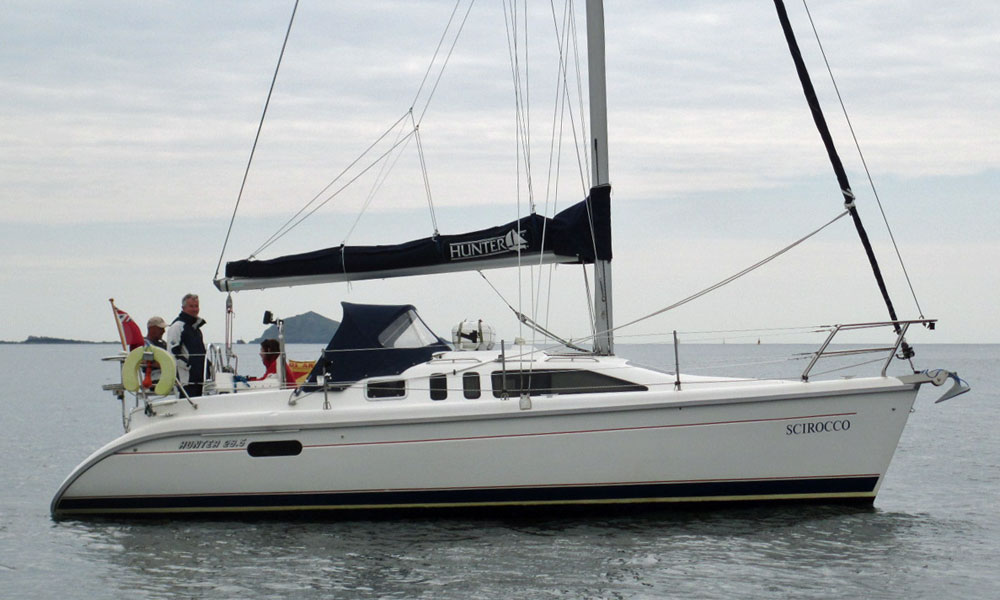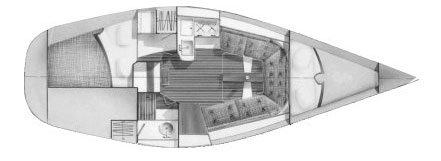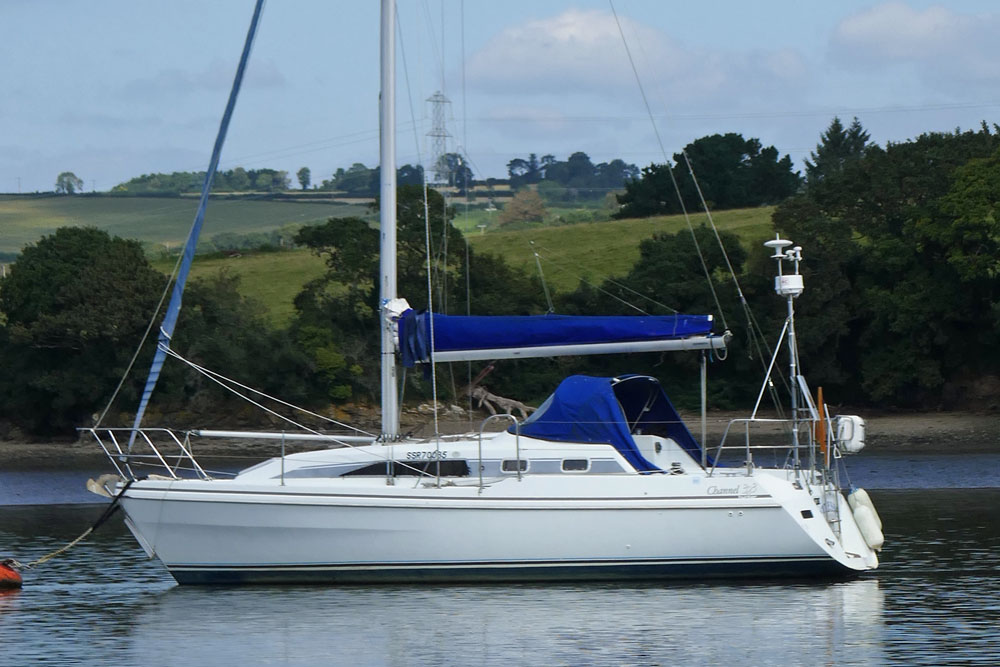- Types of Sailboats
- Parts of a Sailboat
- Cruising Boats
- Small Sailboats
- Design Basics
- Sailboats under 30'
- Sailboats 30'-35
- Sailboats 35'-40'
- Sailboats 40'-45'
- Sailboats 45'-50'
- Sailboats 50'-55'
- Sailboats over 55'
- Masts & Spars
- Knots, Bends & Hitches
- The 12v Energy Equation
- Electronics & Instrumentation
- Build Your Own Boat
- Buying a Used Boat
- Choosing Accessories
- Living on a Boat
- Cruising Offshore
- Sailing in the Caribbean
- Anchoring Skills
- Sailing Authors & Their Writings
- Mary's Journal
- Nautical Terms
- Cruising Sailboats for Sale
- List your Boat for Sale Here!
- Used Sailing Equipment for Sale
- Sell Your Unwanted Gear
- Sailing eBooks: Download them here!
- Your Sailboats
- Your Sailing Stories
- Your Fishing Stories
- Advertising
- What's New?
- Chartering a Sailboat
- Cruiser Yachts under 30'
- Hunter 28.5

The Hunter 28.5 Sailboat
The lack of a backstay on this Hunter 28.5 sailboat tells us that it sports a B&R (Lars Bergström and Sven Ridder) rig.

Published Specification for the Hunter 28.5
Hull Type: Fin keel with spade rudder
Hull Material: GRP (fibreglass)
Length Overall: 28' 5" / 8.7m
Waterline Length: 23' 9" / 7.2m
Beam: 10' 6" / 3.2m
Draft: 5' 2" / 1.6m
Rig Type: B&R
Displacement: 7,000lb / 3,175kg
Sail Area/Displacement Ratio: 17.5
Displacement/Length Ratio: 233
Designer: Hunter Design
Builder: Hunter Marine (USA)
Year First Built: 1985
Year Last Built: 1988
Number Built: not known
Owners Association: The Hunter Association
Published Design Ratios for the Hunter 28.5
Sail Area/Displacement Ratio: 17.5
Ballast/Displacement Ratio: 42.9
Displacement/Length Ratio: 233
Comfort Ratio: 18.8
Capsize Screening Formula: 2.2
read more about these all-revealing numbers...
Summary Analysis of Published Design Ratios for the Hunter 28.5
1. A Sail Area/Displacement Ratio of 17.5 suggests that the Hunter 28.5 will, in the right conditions, approach her maximum hull speed readily and satisfy the sailing performance expectations of most cruising sailors.
2. A Ballast/Displacement Ratio of 42.9 means that the Hunter 28.5 will stand up well to her canvas in a blow, helping her to power through the waves.
3. A Displacement/Length Ratio of 233, tells us the Hunter 28.5 is a moderate displacement cruiser, which means she'll carry all your cruising gear without it having a dramatic effect on her performance. Most of today's sailboats intended for offshore cruising fall into this displacement category.
4. Ted Brewer's Comfort Ratio of 18.8 suggests that crew comfort of a Hunter 28.5 in a seaway is similar to what you would associate with the motion of a coastal cruiser with moderate stability, which is not encouraging news for anyone prone to seasickness.
5. The Capsize Screening Formula (CSF) of 2.2 indicates that a Hunter 28.5 would not be the wisest choice of sailboat for ocean passage-making owing to the lower resistance to capsize in strong winds and heavy seas that is associated with similar sailboats with a CSF of 2.0 and above.
More about the Hunter 28.5...
The Hunter 28.5 is rigged as a sloop with a split backstay and a B&R rig, which means that it has no backstay and uses swept-back spreaders to support the mast. The mast is deck-stepped and has a height of 12.6m (41.33 ft) above the waterline. The sail area is 36.9m² (397 sq ft), with a mainsail of 16m² (172 sq ft) and a genoa of 21m² (226 sq ft).

The boat is powered by an inboard diesel engine with a power of around 15 hp. The fuel tank has a capacity of 42 l (11 gal) and the water tank has a capacity of 102 l (27 gal).
The boat has a hull speed of 7.4 kn (8.5 mph) and a PHRF rating of around 180, which means that it is moderately fast and competitive in its class.
Accommodation The Hunter 28.5 has a spacious and comfortable interior that can accommodate up to six people. The layout consists of:
- A V-berth cabin forward with storage lockers and shelves.
- A head compartment to port with a marine toilet, sink, shower, and storage.
- A hanging locker to port aft of the head.
- A saloon with a U-shaped dinette to port that converts into a double berth, and a settee to starboard that can be used as a single berth.
- A navigation station to starboard aft of the settee with a chart table, electrical panel, and instruments.
- A galley to port aft of the dinette with a two-burner stove, sink, icebox, and storage.
- A private aft cabin to port with a double berth and storage.
The boat has plenty of natural light and ventilation from several opening ports and hatches. The cabin sole is made of teak and holly wood, which adds warmth and elegance to the interior.
Hull and Deck The Hunter 28.5 has a fiberglass hull and deck with wood trim. The hull shape is round-bottomed with a raked stem and a reverse transom. The keel is either a fixed fin keel or an optional shoal draft wing keel, both made of lead. The rudder is an internally-mounted spade-type rudder that is controlled by a wheel in the cockpit.
The deck is wide and flat, with non-skid surfaces for safety and ease of movement. The cockpit is large and comfortable, with high coamings, cushioned seats, and storage lockers. The helm station has an instrument pod, engine controls, compass, and cup holders.
The deck hardware includes two self-tailing two-speed jib sheet winches, two halyard winches on the cabin top, traveler on the arch above the companionway, genoa tracks and cars on the side decks, bow pulpit, stern rail, stanchions, lifelines, anchor roller, anchor locker, cleats, chocks, handrails, swim ladder, etc.
The boat comes standard with a 110% genoa on roller furling system and a mainsail with two reef points on lazy jack system.
The above text was drafted by sailboat-cruising.com using GPT-4 (OpenAI’s large-scale language-generation model) as a research assistant to develop source material; we believe it to be accurate to the best of our knowledge.
Other sailboats in the Hunter range include:

Recent Articles
Wauquiez Gladiateur 33 for Sale
Apr 10, 24 05:40 AM
'Cabo Frio', a Catalina Morgan 43 for sale
Apr 01, 24 08:35 AM
Live Aboard Boats For Sale
Mar 30, 24 07:02 PM
Here's where to:
- Find Used Sailboats for Sale...
- Find Used Sailing Gear for Sale...
- List your Sailboat for Sale...
- List your Used Sailing Gear...

Our eBooks...

A few of our Most Popular Pages...

Copyright © 2024 Dick McClary Sailboat-Cruising.com

- Forums New posts Unanswered threads Register Top Posts Email
- What's new New posts New Posts (legacy) Latest activity New media
- Media New media New comments
- Boat Info Downloads Weekly Quiz Topic FAQ 10000boatnames.com
- Classifieds Sell Your Boat Used Gear for Sale
- Parts General Marine Parts Hunter Beneteau Catalina MacGregor Oday
- Help Terms of Use Monday Mail Subscribe Monday Mail Unsubscribe
Capabilities of the Hunter 28.5
- Thread starter Red_Dog
- Start date May 6, 2020
- Hunter Owner Forums
- Ask A Hunter Owner
I'd like to read some anecdotal "data" on the capabilities of the Hunter 28.5. While the knowledge and skill level of captain and crew do play a large part under what conditions you feel comfortable sailing your boat, I'm looking for a sense of just how far I could push the boat. How many years of sailing experience do you have? Do you single-hand or have a crew? What is the most extreme conditions you have sailed in (wind speed, wave height, etc,)? How were your sails set? Where do you draw the line? Thanks, Alec
Great questions!! Not much different than my 1987 Hunter 31. How many years of sailing experience do you have? 40 years chartering with 11 years sailboat ownership since 2009 Do you single-hand or have a crew? Both on my Hunter 31, 386 and now 46; they are easy to sail, tack and jib with little to no crew. What is the most extreme conditions you have sailed in (wind speed, wave height, etc,)? Generally do not sail in more than 25 knots wind speed and 2 foot waves How were your sails set? Reefed Where do you draw the line? 30 knots and 3 foot waves
sail sfbay said: Great questions!! Not much different than my 1987 Hunter 31. How many years of sailing experience do you have? 40 years chartering with 11 years sailboat ownership since 2009 Do you single-hand or have a crew? Both on my Hunter 31, 386 and now 46; they are easy to sail, tack and jib with little to no crew. What is the most extreme conditions you have sailed in (wind speed, wave height, etc,)? Generally do not sail in more than 25 knots wind speed and 2 foot waves How were your sails set? Reefed Where do you draw the line? 30 knots and 3 foot waves Click to expand
Wow with those conditions you can sail anywhere!! Please note the heavier and longer the sailboat the more comfortable the sailing experience is. On a 39 foot full keel sailboat yesterday in the SF Bay with 25 knot winds and 1 - 2 foot waves.............very smooth.
With my 28.5, there have been a few occasions where the boat nose dived and I've taken water over the bow. The first time it was an "oh, wow", that was unexpected experience. Now I just expect it anytime the maritime forecast is for 2'-3' waves.
Yeah.....used to pitch pole our Hobie Cat in those conditions in the Long Island Sound but you still manage a 28.5 sailboat depending on your point of sail. Others in this forum can offer more advise on sailing a 28.5 Hunter in those conditions.
David in Sandusky
We have a ‘77 h27, so we are a bit smaller than you. We sail in the same area, How many years of sailing experience do you have? 55 Do you single-hand or have a crew? Mostly it’s the Admiral and I, but we’ve cruised with 4 aboard, and I have single handed. What is the most extreme conditions you have sailed in (wind speed, wave height, etc,)? 45 knots on Sandusky Bay. 6 footers in 25 knot winds crossing to Erieau. 45 knots on my Sunfish in Key West - that was a hoot! How were your sails set? Double reef in the main, and about half of our 110 genny. Where do you draw the line? I don’t plan to sail over 30 knots, but we felt safe in 45. 6 foot waves were fine on a reach. I wouldn’t plan a close hauled beat into 4 footers. We always plan layover days to avoid bad winds/weather. The key for us is the weather apps on our phones. Mostly it’s about avoiding the thunderstorm lines that are easy to see on radar. The only other idea is to get off the Lake by 4 PM on a hot summer day. Pop-up thunderstorms are possible near shore in those conditions. Lastly, your 28.5 is can probably take a whole lot more than you can! We are talking about our limits here, not the boat’s.
David in Sandusky said: What is the most extreme conditions you have sailed in (wind speed, wave height, etc,)? 45 knots on Sandusky Bay. 6 footers in 25 knot winds crossing to Erieau. 45 knots on my Sunfish in Key West - that was a hoot! How were your sails set? Double reef in the main, and about half of our 110 genny. Click to expand
Keep your head - that is key. And reduce sail. I should add that our second reef in the main is a third reef. That is we had minimum mainsail up, so the heel was not excessive, and we could motor sail. In that case, back to our marina!
David in Sandusky said: Keep your head - that is key. And reduce sail. I should add that our second reef in the main is a third reef. That is we had minimum mainsail up, so the heel was not excessive, and we could motor sail. In that case, back to our marina! Click to expand
Red_Dog said: I'd like to read some anecdotal "data" on the capabilities of the Hunter 28.5. While the knowledge and skill level of captain and crew do play a large part under what conditions you feel comfortable sailing your boat, I'm looking for a sense of just how far I could push the boat. How many years of sailing experience do you have? Do you single-hand or have a crew? What is the most extreme conditions you have sailed in (wind speed, wave height, etc,)? How were your sails set? Where do you draw the line? Would you consider sailing an H28.5 from New England to the Caribbean, and back again, without using the Intercontinental Waterway? Thanks, Alec Click to expand
Red Dog. Boats go from the Coast of Maine to the Caribbean. They just do it in good weather and without a dead line to get there. Given that you choose safe weather and cruise the coast where you can find safe harbor when the weather changes you'll be fine in your Hunter 28.5. Heck you might be fine in a dinghy with a 8 ft make shift sail. If that is the boat you got and it is paid for, I say go for it.. And as you say "Keep your Head". Just promise to send the occasional photo back to us here on the forum.
- This site uses cookies to help personalise content, tailor your experience and to keep you logged in if you register. By continuing to use this site, you are consenting to our use of cookies. Accept Learn more…
Great choice! Your favorites are temporarily saved for this session. Sign in to save them permanently, access them on any device, and receive relevant alerts.
- Sailboat Guide
Hunter 28.5
Hunter 28.5 is a 28 ′ 4 ″ / 8.7 m monohull sailboat designed by Hunter Design and built by Hunter Marine between 1985 and 1988.

- 2 / 9 Houston, TX, US 1986 Hunter 28.5 $12,500 USD View
- 3 / 9 Houston, TX, US 1986 Hunter 28.5 $12,500 USD View
- 4 / 9 Houston, TX, US 1986 Hunter 28.5 $12,500 USD View
- 5 / 9 Houston, TX, US 1986 Hunter 28.5 $12,500 USD View
- 6 / 9 Houston, TX, US 1986 Hunter 28.5 $12,500 USD View
- 7 / 9 Houston, TX, US 1986 Hunter 28.5 $12,500 USD View
- 8 / 9 Houston, TX, US 1986 Hunter 28.5 $12,500 USD View
- 9 / 9 Houston, TX, US 1986 Hunter 28.5 $12,500 USD View
Rig and Sails
Auxilary power, accomodations, calculations.
The theoretical maximum speed that a displacement hull can move efficiently through the water is determined by it's waterline length and displacement. It may be unable to reach this speed if the boat is underpowered or heavily loaded, though it may exceed this speed given enough power. Read more.
Classic hull speed formula:
Hull Speed = 1.34 x √LWL
Max Speed/Length ratio = 8.26 ÷ Displacement/Length ratio .311 Hull Speed = Max Speed/Length ratio x √LWL
Sail Area / Displacement Ratio
A measure of the power of the sails relative to the weight of the boat. The higher the number, the higher the performance, but the harder the boat will be to handle. This ratio is a "non-dimensional" value that facilitates comparisons between boats of different types and sizes. Read more.
SA/D = SA ÷ (D ÷ 64) 2/3
- SA : Sail area in square feet, derived by adding the mainsail area to 100% of the foretriangle area (the lateral area above the deck between the mast and the forestay).
- D : Displacement in pounds.
Ballast / Displacement Ratio
A measure of the stability of a boat's hull that suggests how well a monohull will stand up to its sails. The ballast displacement ratio indicates how much of the weight of a boat is placed for maximum stability against capsizing and is an indicator of stiffness and resistance to capsize.
Ballast / Displacement * 100
Displacement / Length Ratio
A measure of the weight of the boat relative to it's length at the waterline. The higher a boat’s D/L ratio, the more easily it will carry a load and the more comfortable its motion will be. The lower a boat's ratio is, the less power it takes to drive the boat to its nominal hull speed or beyond. Read more.
D/L = (D ÷ 2240) ÷ (0.01 x LWL)³
- D: Displacement of the boat in pounds.
- LWL: Waterline length in feet
Comfort Ratio
This ratio assess how quickly and abruptly a boat’s hull reacts to waves in a significant seaway, these being the elements of a boat’s motion most likely to cause seasickness. Read more.
Comfort ratio = D ÷ (.65 x (.7 LWL + .3 LOA) x Beam 1.33 )
- D: Displacement of the boat in pounds
- LOA: Length overall in feet
- Beam: Width of boat at the widest point in feet
Capsize Screening Formula
This formula attempts to indicate whether a given boat might be too wide and light to readily right itself after being overturned in extreme conditions. Read more.
CSV = Beam ÷ ³√(D / 64)
Shoal draft/wing keel: 4’/1.21m
Embed this page on your own website by copying and pasting this code.

Discover Related Sailboats

- About Sailboat Guide
©2024 Sea Time Tech, LLC
This site is protected by reCAPTCHA and the Google Privacy Policy and Terms of Service apply.

IMAGES
VIDEO